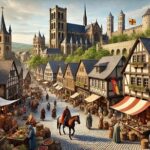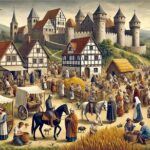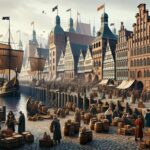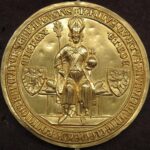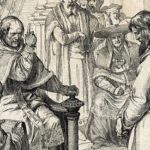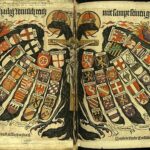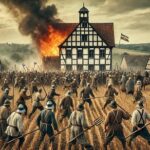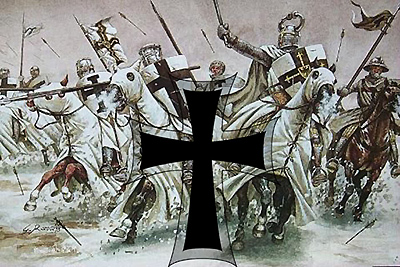
Crosses on shields. Swords in hand. Cloaks fluttering behind rows of disciplined knights. In the snowy forests and Baltic frontiers, the Teutonic Knights carved out a unique role in medieval German history—not just as warriors, but as agents of empire.
What began as a humble hospital order during the Crusades became one of the most powerful and controversial forces in medieval Europe. The Teutonic Order didn’t just fight—they built castles, governed cities, and shaped a vast region stretching from the Baltic Sea into modern-day Russia.
Let’s follow their journey from Jerusalem to Prussia and explore how their expansion eastward shaped the history of Germany—and of Eastern Europe—for centuries to come.
Origins: From the Holy Land to the Baltic
The Teutonic Order was founded in 1190 during the Third Crusade, originally as a charitable hospital for German pilgrims in Acre. Modeled after the Templars and Hospitallers, the order quickly transformed into a military and religious brotherhood.
In 1199, Pope Innocent III formally recognized them as a military order. Their mission? To defend Christendom—wherever that battle might be fought. After the Crusades in the Holy Land faltered, they shifted their focus to northern and eastern Europe, where the last major pagan groups still resisted Christianization.
The Baltic Frontier: Pagan Lands and Political Opportunity
Eastern Europe in the 13th century was a volatile frontier:
- Pagan Prussians, Lithuanians, and Latgalians still practiced traditional religions.
- The Polish dukes struggled to defend their borders.
- The Church sought to expand Christian influence beyond Germany.
In 1226, Polish Duke Konrad of Mazovia invited the Teutonic Knights to help subdue the Old Prussians. In return, they received Chełmno Land and papal permission to govern any conquered territories.
This launched a military and religious campaign that would last over a century.
Crusade and Conquest
The Teutonic Knights quickly organized a network of military campaigns:
- They defeated and forcibly baptized pagan tribes.
- They built powerful castles like Marienburg, Königsberg, and Thorn.
- They established German-speaking colonies, often bringing settlers from the Rhineland and Saxony.
Life was brutal on both sides:
- Villages were burned, populations displaced, and forced conversions common.
- Resistance by native tribes was fierce and often fueled by neighboring Lithuanian rulers.
The Prussian Crusades were justified by the pope as holy wars—but they also served German expansionist goals.
The Monastic State: Rule by Sword and Scripture
By the 14th century, the Order had established a unique political entity: a monastic military state governed by the Grand Master.
Key features included:
- A hierarchical administration: commanders, castellans, and magistrates ruled towns and provinces.
- A centralized economy: taxes, tolls, and trade monopolies financed the state.
- A network of Teutonic castles served as both fortresses and administrative hubs.
Settlers founded towns like:
- Danzig (Gdańsk) – a trade powerhouse
- Elbing (Elbląg) and Kulm (Chełmno) – major colonial centers
The knights also invited clergy, artisans, and merchants to form a stable, productive society—with German laws, urban charters, and Christian norms.
Urban Life and Cultural Transformation
The Order didn’t just conquer land—they reshaped it:
- Cities were built on gridded layouts with central market squares and churches.
- Latin and German became administrative languages.
- Trade flowed through the Hanseatic League, connecting Prussia to Lübeck, Riga, and Bruges.
Despite harsh beginnings, many regions flourished. Towns developed unique identities, blending German, Slavic, and Baltic influences.
Knights were expected to uphold justice and maintain order, but abuses did occur, especially toward local populations who remained culturally or religiously distinct.
Conflicts with Poland and Lithuania
The Order’s expansion alarmed neighboring powers. The biggest threat came from the growing union of Poland and Lithuania, forged by the marriage of Jogaila of Lithuania and Queen Jadwiga of Poland.
In 1386, Jogaila converted to Christianity—undermining the Knights’ primary excuse for war.
Tensions escalated until the epic Battle of Grunwald (Tannenberg) in 1410, where the Order suffered a devastating defeat. Although they survived politically, their decline had begun.
Subsequent conflicts led to the Second Peace of Thorn (1466):
- The Order lost major western territories (Royal Prussia) to Poland.
- The Grand Master became a Polish vassal.
The balance of power shifted decisively.
Secularization and Reformation
In 1525, Grand Master Albert of Brandenburg-Ansbach, influenced by the Protestant Reformation, dissolved the religious state.
He:
- Converted to Lutheranism
- Secularized the Order’s lands
- Founded the Duchy of Prussia, the first Protestant state in Europe
This marked the end of the Teutonic Knights as a sovereign power—but their legacy persisted.
Long-Term Legacy
The Order’s legacy is vast and complicated:
- They spread Christianity and German culture across the Baltic
- Their urban planning laid foundations for many modern cities
- Their symbols were later co-opted by German nationalists and militarists
In modern times, debates continue:
- Were they agents of civilization or colonial oppressors?
- Did they foster development or destroy native identities?
Both are partly true—and that duality defines their legacy.
Modern Echoes
Many cities once ruled by the Order still bear traces of their influence:
- Castles, cathedrals, and medieval street layouts remain.
- In Poland, Lithuania, and Russia, historical memory varies—admiration mixed with ambivalence.
- The Order continues as a Catholic charitable organization, based in Vienna, focused on hospital work.
Their story lives on in films, novels, and even video games—as symbols of chivalry, zealotry, and empire.
The Teutonic Knights represent one of the most fascinating and controversial chapters in medieval German history. Their crusade eastward wasn’t just a religious mission—it was a blueprint for conquest, colonization, and cultural transformation.
Their rise and fall tell us how borders shift, how power changes hands, and how identities are built—or broken—through time. To dig deeper, check out Medieval German Feudal Society, German Castles and Medieval Architecture, or The Holy Roman Empire to explore how knightly power shaped a continent.
The Middle Ages in German History – An overview of the political, cultural, and religious transformations that shaped Germany from the fall of the Carolingian Empire to the dawn of the Reformation, including the rise of the Holy Roman Empire and medieval society.
Otto I and the Birth of the Holy Roman Empire – Explore how Otto I’s coronation in 962 marked the formal beginning of the Holy Roman Empire, establishing a powerful political and religious legacy in medieval Germany.
Medieval German Feudal Society – Learn how landholding, loyalty, and class defined the social structure of medieval Germany, shaping both everyday life and royal authority.
The Hanseatic League – Discover the rise of this powerful trade alliance of northern German cities that dominated commerce across the Baltic and North Seas during the late Middle Ages.
German Castles and Knightly Culture – Dive into the architectural and chivalric world of medieval Germany, where fortified castles and knightly ideals shaped warfare, literature, and noble identity.
The Investiture Controversy – A pivotal power struggle between church and state, this conflict reshaped the relationship between emperors and popes across the German medieval landscape.
The Black Death in Germany – Trace the devastating impact of the 14th-century plague on German towns and villages, altering demographics, labor systems, and religious life.
Peasant Revolts in the Middle Ages – Examine the causes and consequences of peasant uprisings in medieval Germany, including their role in challenging feudal oppression and economic hardship.
The Teutonic Knights and Eastern Expansion – Follow the military and missionary campaigns of the Teutonic Order as they expanded Germanic influence eastward into pagan territories.
German Medieval Universities – Explore the intellectual revival of the High Middle Ages, as cathedral schools and universities flourished in German cities, preserving classical knowledge and fostering new ideas.
The Golden Bull of 1356 – Understand the constitutional landmark that formalized the election of German kings, shaping imperial governance in the Holy Roman Empire for centuries.
